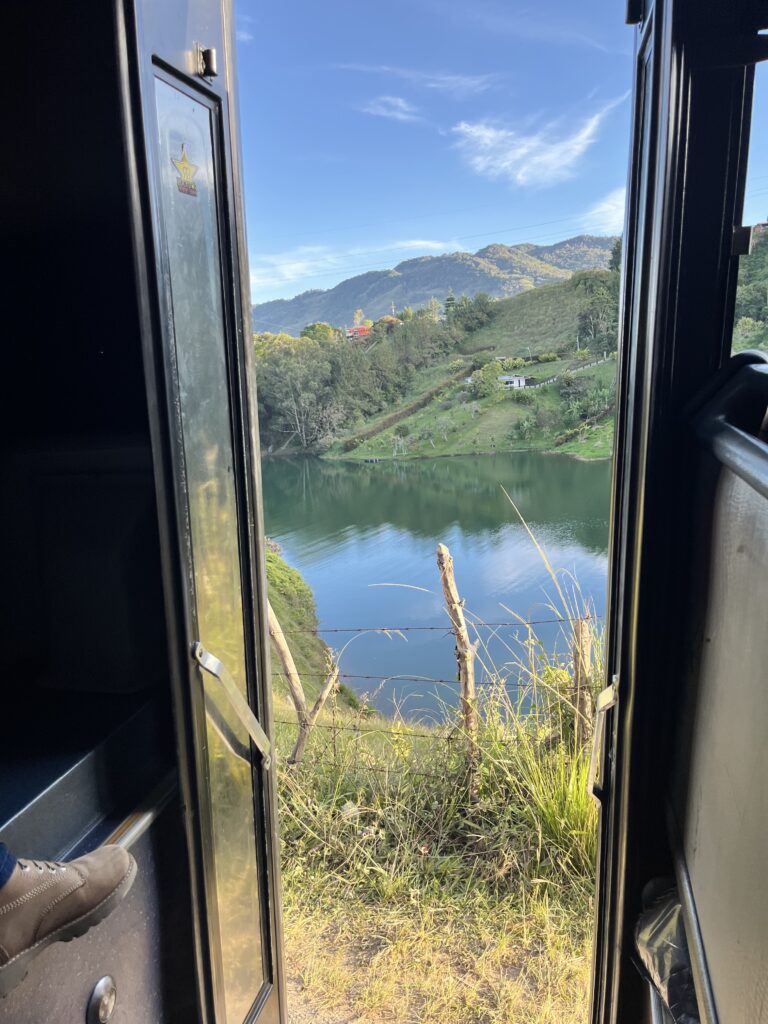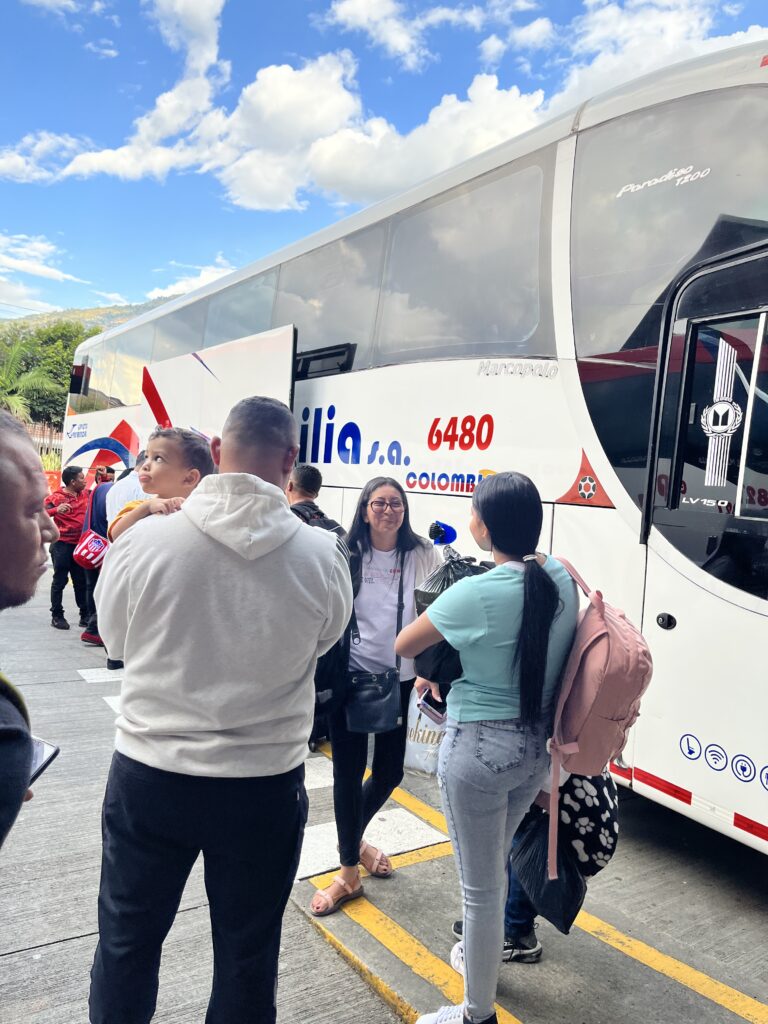I’ve now spent over a year in Colombia, cumulatively. I’ve been living here for almost nine months now, so I’ve had a lot of time to observe the differences between Colombian culture and American culture. Obviously, there are a ton, and many are so big that you notice them right away. But the things that interest me the most are the ones that take a little while to uncover, but which pop up regularly in my day-to-day.
You may have noticed that I like lists. The Little Cultural Things list is one of many in the Notes app on my phone. These are things that have frustrated, delighted, or just surprised me as someone coming from the United States. I’ve been wanting to write a series of posts about these observations, so this is the first of a few that I’ll share in the coming months.
Colombians Wink with Two Eyes
File this one under “delightful”. I call it the Two-Eyed Wink, and it happens most commonly when you make direct eye contact with a Colombian by accident, like in a group conversation when neither of you is speaking, or from across the room in a public space. They give you a little smile, and quickly squeeze both eyes shut and open them again. It’s like a blink, but it lasts a few milliseconds longer, and involves a little more action from the muscles around the eyes.
I call it a wink because it’s similar to the one-eye wink that we have in the US. It’s a micro-gesture with elements of acknowledgment and complicity–it’s playful. But the Two-Eyed Wink has no trace of sexual innuendo. If you wink at someone in the US, you have to be careful, thinking about who you are, who the wink receiver is, and how they are going to interpret it. I’ve had conversations with friends about who can “pull off” a friendly wink, and it’s not everybody.
But in Colombia, I’ve received the Two-Eyed wink from women, men, strangers, and acquaintances, and there’s never an uncomfortable undertone. It’s just a silent, Hi. I see you. Isn’t it nice to share this little moment? I find it super endearing, and I always respond with a little Two-Eyed Wink of my own.
Everywhere is a Bus Stop
I admittedly found this one frustrating at first. I will start by saying that Colombia has excellent bus transportation. Only the really big cities like Medellín and Bogotá have government-funded public transit, but you can go almost anywhere you want using the vast network of privately owned bus companies. In Manizales, where I live now, at least four companies operate busetas, or small buses, on different routes through the city. It costs about $0.65 USD per ride, and there are so many busetas that you’re usually not waiting long.
And if you want to travel between cities, it’s easy to head to the bus terminal and buy an affordable ticket to wherever you need to go. As I mentioned in my post about helpful apps for travel, I often use Rome2Rio to figure out the routes and companies.
Before beginning my big trip, I hadn’t done a lot of public bus travel. In the US I always had a car. Where I grew up in Hawaii, public transportation isn’t widely available or widely used. And in Colorado, it might take you twice as long to get to your destination on the bus. So being in a place where I can easily cross the city or the country in a bus is novel for me. However, I still had some expectations about how buses work based on my experiences in the US. Namely, that buses stop at bus stops, and that’s where you get on and off. Not the case in Colombia.
My First Bus Chaos

When I first arrived in Colombia, after a week in Medellín, I headed off to the volunteering job I’d secured in a rural area a few hours away from the city. I took a bus, and due to holiday weekend traffic and heavy rain, the ride that should’ve taken three hours took about seven. I’d purchased my ticket at the bus terminal in Medellín, and I figured that the bus would stop in the towns that had been listed on the route at the terminal. To my consternation, the bus driver pulled over constantly to pick up people who flagged him down from the side of the road. Even when there were no seats left on the bus.
People hopped on for short rides between towns, asking the driver to stop wherever they wanted, and as they got off, the driver told them how much they owed, which they handed over in cash. I am not positive, but I suspect that this is a common Colombian bus driver side hustle. There are people who buy tickets at the desk at the bus terminal, but if the driver picks up people informally on the side of the road, he probably keeps that money. Even big inter-city coach buses do this sometimes.
Expectation vs. Reality
I remember feeling confused and annoyed. It wasn’t exactly that these extra stops were keeping us from getting to our destination faster, the traffic would’ve been just as slow either way. But the whole thing felt chaotic to me, and I was coming in with my American expectation of orderliness.
I found that pretty much all buses in Colombia are like this. Bus stops exist, but people mostly just stand on the side of the road and watch for the bus they want to take, flagging it down like a taxi. The bus stops, they get on, and then they can also ask the driver to stop anywhere. If you’re not familiar with the routes or don’t speak Spanish, this can be challenging and stressful. You have to know by sight which bus you want and where you want to get off.
Getting Used to It
When I think about it, I am still of the opinion that this is an inefficient system, particularly in the city. Sometimes there are two people flagging down the same bus, standing 10 meters apart, and the bus will stop twice. Sometimes the bus driver doesn’t see you flagging him down, and you have to wait for the next one to drive by. As far as I can tell, you’re supposed to just know the routes based on the signs in the windshield which indicate the neighborhoods the bus will pass through. There are no signs with route maps posted at bus stops, probably because there are so many different bus companies and so few actual bus stops.
Nonetheless, this hasn’t bothered me for a long time. I spent some time in Nicaragua last year and experienced true bus chaos that made me miss Colombia. After living in Manizales a while, I’m familiar enough with the city and my regular routes to know which bus to flag down. I glance at Google Maps en route to make sure I request a stop in the right place. If I’m unfamiliar with the route, I can ask for help in Spanish and understand the answer I get.
I appreciate how convenient it is to have the bus pick me up and drop me off wherever works best for me. Furthermore, not having a car for the first time in over a decade comes with a surprising amount of freedom and ease. I don’t pay for maintenance, gas, or insurance.

That seems to me to be a better, more efficient, more ecologically sound, cheaper system than here (Hawaii) where most everyone needs and has a car.
So true! Imagine if there were a bunch of people with electric mini-buses driving back and forth across the island all day. I feel like there’s a good business opportunity there.
I’m so curious – how many seats are on these buses? I’m imagining the shorter routes are more like passenger vans, maybe 10 seats like the summer camp buses of my childhood haha
I was actually just trying to count this last night! I think most of the city buses in Manizales have between 18 and 24 seats. I have ridden a few smaller ones that are probably more like 15.